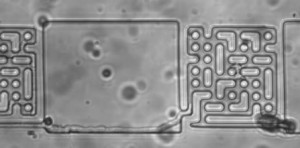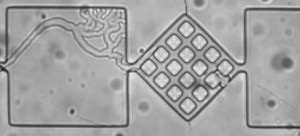About our research
We are focusing on the design and the fabrication of artificial biomedical devices and the study of natural or hybrid biological devices – all operating in micro- or nano-confined media.
Research interface
Our research is placed at the interface between biomedical and biological, micro- & nano-, and increasingly, information engineering. All of these three areas contribute to our research both as tools and enablers, as well as applications and markets.
Interaction of biomolecules and cells with surfaces
Our research focus on the design, fabrication and operation of planar micro/nano-devices hosting biomolecules and cells. The interactions between biomolecules and cells with engineered surfaces are 1D interactions (with flat surfaces); 2D or 3D interactions (with micro/nano-structures); or 4D interaction (dynamic, i.e., 3D+time).
More Moore, No Moore, and Further Moore’s Laws
Our research gravitates around, and afar from Moore’s Law, which predicts (or dictates) the steady progress of the fabrication technology towards ever smaller structures. Building on our experimental capability and expertise in micro and nanofabrication ("More Moore" research), we develop biomedical micro- and nanodevices ("No Moore" research). More recently, building on the expertise in developing biomedical devices, we are increasingly interested in microfluidics devices, be they natural, artificial or hybrid, where size is not critical, but the complexity is, such as biocomputation and biosimulation devices ("Further Moore" research).
Dan's research group's interests are motivated by two mega trends: the advances in micro- and nano-fabrication, following the Moore’s Law-driven relentless progress in semiconductor manufacturing; and the “engineerisation” of Biology and Medicine. The synergy between these two trends resulted in three major Research Streams of the group, each using both experimental and computational methodologies: the application of the Engineering principles and methodology to Biology and Medicine ("Further Moore"); the application of semiconductor technologies and devices to Biology and Medicine ("No Moore"); and micro/nano-fabrication ("More Moore").
"Further Moore": The Engineering of Biology – at the micro, nano and info-level.
We apply engineering methodology, in particular mathematically-informed modelling and design, to understand biomolecular and cellular processes, thus making them predictable. This forward-understanding of biological processes opens the possibility of ‘reverse engineering’ of natural biodevices into artificial, or hybrid ones. Examples of projects under this Research Stream:
- Engineering-orientated description of the interaction between biomolecules or cells and surfaces, leading to the design of biomolecule-specific nano-structured surfaces..
- Reverse-engineering of the algorithms used by microorganisms for space searching in microfluidics devices, leading to the physical simulation of large-scale traffic networks.
- Description of biomolecular surfaces at atom-level resolution and the application of image recognition algorithms for their classification, leading to new drug discovery avenues.
“No Moore": Towards the functional integration of biomolecules and semiconductor devices.
This Research Stream aims to go beyond the present application of microfabricated devices in Biology and Medicine, such as biosensors, bioMEMS, microarray and lab-on-a-chip devices, and advance on the biologically-informed design, fabrication and operation of bio-nano-devices. This Research Stream comprises projects such as:
- Use of protein molecular motors in hybrid nanodevices for diagnostic, high throughput screening and biosimulation.
- Fabrication of nanostructures using the natural self-assembly of biomolecules, e.g., cytoskeletal and amyloid proteins.
- Single molecule devices, e.g., DNA electronics devices and ultra-sensitive protein-based detection devices.
"More Moore": At the limits of micro- and nano-fabrication.
We study, both from an experimental and simulation point of view, the physico-chemical processes involved in micro- and nano-fabrication, and the manipulation of nano-objects. One specific area that we are interested in is the integration of self-assembly processes with the fabrication of nanostructures using micro-level fabrication techniques. Examples of research projects:
- Impact of micro/nano-structures on wetting with nano-droplets.
- Micro- and nano-fabrication in a biomolecular biology lab, using confocal and Atomic Force microscopies.
- Self-organisation of materials, at the nano-level, when exposed to focused energy beams, e.g., laser beams.
For us, the best return-on-investment of academic is obtained when focusing on new engineering knowledge derived from biology. (And it is more fun). Much of this programmatic focus comes from Claasen’s seminal analysis on technology development. You can read Claasen’s article here.





